
The Queensway Tunnel is a road tunnel under the River Mersey, in the north west of England, between Liverpool and Birkenhead. Locally, it is often referred to as the "Birkenhead Tunnel" or "old tunnel", to distinguish it from the newer Kingsway Tunnel (1971), which serves Wallasey and the M53 motorway traffic. At 3.24 kilometres (2.01 mi) in length, it is the longest road tunnel in the UK.

Liverpool Lime Street is a terminus railway station and the main station serving the city centre of Liverpool. Opened in August 1836, it is the oldest still-operating grand terminus mainline station in the world. A branch of the West Coast Main Line from London Euston terminates at the station, as does the original Liverpool and Manchester Railway. Journeys from Lime Street cover a wide range of destinations across England, Scotland and Wales.
Nationwide Building Society is a British mutual financial institution, the seventh largest cooperative financial institution and the largest building society in the world with over 16 million members. Its headquarters are in Swindon, England.
The Woolwich Equitable Building Society was founded in Woolwich in 1847 and remained a local institution until after WWI when it began a modest regional expansion. This accelerated after WWII and the period from 1960 was notable for its acquisitions. Following deregulation, the Society diversified and became one of the largest national building societies.
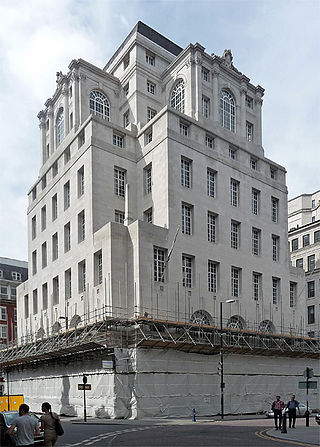
100 King Street, formerly the Midland Bank, is a former bank premises on King Street in Manchester, England. It was designed by Sir Edwin Lutyens in 1928 and constructed in 1933–35. It is Lutyens' major work in Manchester and was designated a Grade II* listed building in 1974.
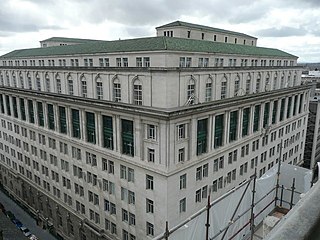
India Buildings is a commercial building with its principal entrance in Water Street, Liverpool, England. Mainly an office building, it also contained an internal shopping arcade and the entrance to an underground station. It was built between 1924 and 1932, damaged by a bomb in 1941, and later restored to its original condition under the supervision of one of its original architects. The building, its design influenced by the Italian Renaissance and incorporating features of the American Beaux-Arts style, occupies an entire block in the city.

108 St Georges Terrace or Palace Tower is a 50-storey office tower in Perth, Western Australia. Completed in 1988, the building measures 214 metres (702 ft) to its roof and 247 metres (810 ft) to the tip of its communications antenna. It was the tallest building in Perth from its completion in 1988 until 1992 when it was overtaken in height by Central Park. As of 2023, it is the third-tallest building in the city. The concrete tower has a distinctive profile, with a triangular plan.

The Lyceum is a Neoclassical Grade II* listed building located on Bold Street, Liverpool. It was constructed in 1802 as a news-room and England's first subscription library (1758–1942) and later became a gentleman's club. After the club relocated in 1952 the building was left unoccupied for many years, eventually falling into a state of disrepair. Calls were made for its demolition in the late 1970s, sparking a campaign to save the building. It reopened as a post office, and then a branch of the Co-operative Bank. As of May 2024, its tenants are a Chinese restaurant and a miniature golf and bar venue called One Below.

Maybourne is a Qatari-owned British luxury hotel operator, which owns and manages The Berkeley, Claridge's,The Connaught and The Emory in London, The Maybourne Beverly Hills in Los Angeles and The Maybourne Riviera in Roquebrune-Cap-Martin.

Stafford railway station is a major interchange railway station in Stafford, Staffordshire, England, and is the second busiest railway station in Staffordshire, after Stoke-on-Trent. The station serves the market and county town, as well as surrounding villages. The station lies on the junction of the Trent Valley line, the Birmingham Loop/Rugby–Birmingham–Stafford line, and the West Coast Main Line.
EasyHotel is an international hotel chain, headquartered in London with 40 branches in ten European countries.

The Coal Exchange is a historic building in Cardiff, Wales. It is designed in Renaissance Revival style. Built in 1888 as the Coal and Shipping Exchange to be used as a market floor and office building for trading in coal in Cardiff, it later became a hub of the global coal trade. It is situated in Mount Stuart Square in Butetown, and was for many years the hub of the city's prosperous shipping industry.
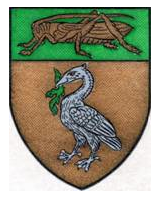
Martins Bank was a London private bank, trading for much of its time under the symbol of “The Grasshopper”, that could trace its origins back to Thomas Gresham and the London goldsmiths, from which it developed into a bank known as Martin's Bank from 1890. That bank was acquired in 1918 by the Bank of Liverpool, which wanted Martins to give it a London presence and a seat on the London Bankers' Clearing House. The Martin name was retained in the title of the enlarged bank which was known as the Bank of Liverpool and Martins Limited. The title was shortened to Martins Bank Limited in 1928 at the insistence of the directors of the Lancashire and Yorkshire Bank when it was bought by the Bank of Liverpool and Martins. The head office and managerial control remained firmly in Liverpool, cementing Martins' place as the only English national bank to have its head office outside London. It was taken over in 1969 by Barclays.
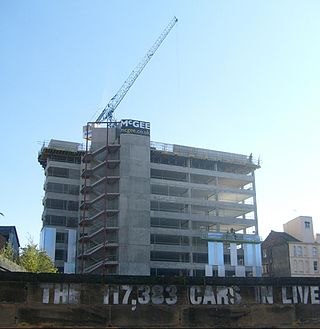
Central Village is a shopping, leisure, commercial and residential development that is currently under construction in Liverpool, England, United Kingdom. The complex is being built over Liverpool Central railway station, the UK's busiest underground station outside London. The core of the project is two high rise blocks of 25 and 20 floors linked by a 9-storey residential and commercial podium and two nine and five storey buildings for residential, hotel and commercial use. The development is by Merepark and is predicted to cost roughly £160 million. It is one of a number of ambitious projects to take place in Liverpool city centre in the early 21st century - other developments being Liverpool One, King's Dock, Prince's Dock, Lime Street Gateway, Metquarter and developments in the Commercial District. The proposed development includes the famous Lewis's department store building. Besides the residential, commercial and leisure aspects of the development, there will also be a number of office buildings and a large QPARK multi-storey car park - which will be the first part of Central Village to be completed in 2011. Planning permission was granted for the project by Liverpool City Council in May 2009, and final approval was given for construction of the entire complex to commence in February 2010. The entire Central Village scheme was due for completion in 2015 however is still to be completed due to a series of delays.

The economy of Liverpool encompasses a wide range of economic activity that occurs within and surrounding the city of Liverpool, England.
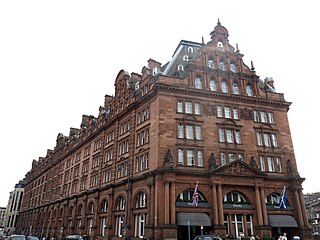
The Waldorf Astoria Edinburgh - The Caledonian is a five-star hotel in Edinburgh, Scotland. Opened in 1903, it is an example of a British grand railway hotel, formerly called The Caledonian Hotel, and nicknamed 'The Caley'. It stands at the west end of Princes Street and is a category A listed building.
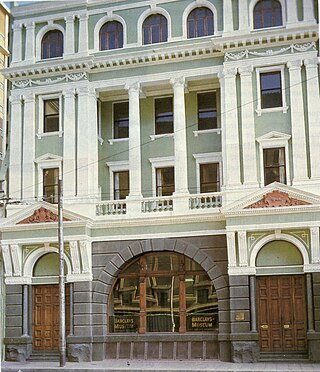
The Natal Bank Building is situated on Stand 194 at 90 Market Street in the city of Johannesburg. Natal Bank was the second bank to open a branch in the city after Standard Bank.

The Mandarin Oriental Manila was a hotel along Makati Avenue in Makati, Metro Manila, Philippines, managed by the Mandarin Oriental Hotel Group and designed by National Artist Leandro Locsin.

Commercial Banking Company of Sydney (CBC), Campbelltown Branch is a heritage-listed former restaurant, offices and bank building and now medical centre located at 263 Queen Street, Campbelltown in the City of Campbelltown local government area of New South Wales, Australia. It was designed by Mansfield Brothers and built from 1874 to 1881. It is also known as Old CBC Bank; CBC Bank. The property is privately owned. It was added to the New South Wales State Heritage Register on 2 April 1999.

Johnson Square is one of the 22 squares of Savannah, Georgia, United States. Located in the northernmost row of the city's five rows of squares, it was the first of the squares to be laid out, in 1733, and remains the largest of the 22. It is east of Ellis Square, west of Reynolds Square and north of Wright Square. Situated on Bull Street and St. Julian Street, it is named for Robert Johnson, colonial governor of South Carolina and a friend of General James Oglethorpe. The oldest building on the square is the Ann Hamilton House, at 26 East Bryan Street, which dates to 1824.





















